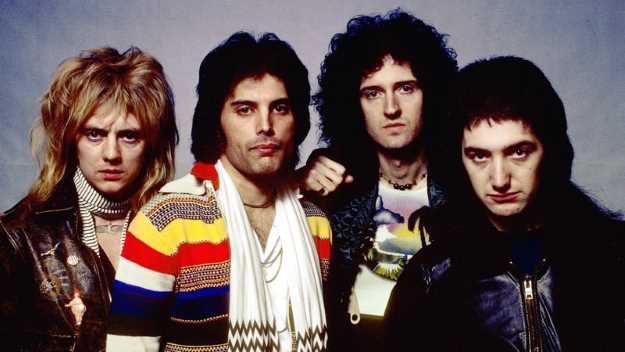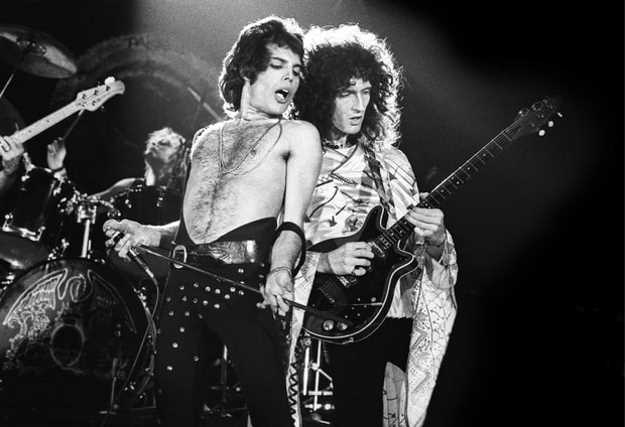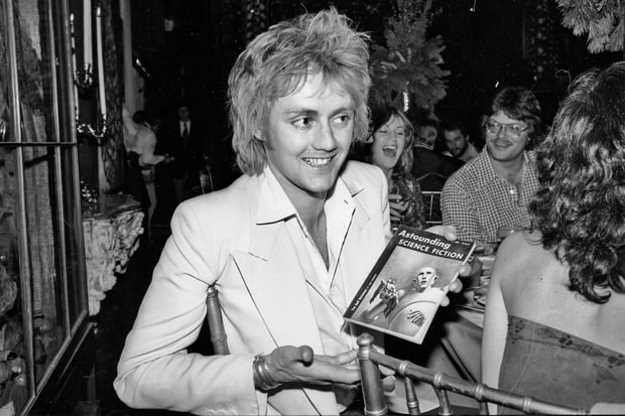| |
Taken from Rolling Stone (Oct 28, 2017)
Queen’s “News of the World”: 10 Things You Didn’t Know
From a Freddie Mercury–Sid Vicious studio run-in to how Brian May made those stomps and claps on "We Will Rock You" sound so huge
by Dan Epstein

Read 10 things you likely didn't know about Queen's 1977 smash 'News of the World.' Credit: Richard E. Aaron/Getty Images |
Though now rightly regarded as one of the greatest rock bands of all time, Queen were experiencing something of a midlife crisis in the summer of 1977, when Freddie Mercury, Brian May, John Deacon and Roger Taylor reconvened to begin work on their sixth studio album.
Their previous record, 1976's A Day at the Races, had peaked at Number Five in the U.S. and topped the charts in the U.K. – but it had also sold considerably fewer copies than their 1975 blockbuster, A Night at the Opera. Reviews of the album and its accompanying North American and U.K. tour dates had not been particularly kind, either; in a Rolling Stone review from February 24th, 1977, Dave Marsh wrote of the band, "They have managed to borrow all that's frothiest from their influences, from the fake-orgasmic vocal contortions of Robert Plant to the semi-vaudevillian pop of the Beach Boys and Beatles. In addition, to cement their 'seriousness,' they use instrumental effects which hint at opera in the same way that bad movie music palely evokes the symphony."
To make matters worse, the rise of punk and New Wave was also calling into question the relevance of Seventies arena rock, and Queen suddenly found themselves cast as dinosaurs whose epoch of dominance was rapidly fading. Rather than double down with another lavishly overdubbed studio creation, the band responded by recording the most stripped-down and straightforward album of their career, one which went for a leaner, more spontaneous sound and feel while still retaining the melodic flamboyance and hard-rock heft of their multi-layered earlier work. The resulting LP, News of the World, was released on October 28th, 1977; thanks in part to the two-sided smash of "We Will Rock You" and "We Are the Champions," it has gone on to become the best-selling album of the band's career, moving more than 4 million copies in the U.S. alone. (A deluxe box-set reissue of News of the World is due out on November 17th.)
On the 40th anniversary of the album's original release, here are 10 things you probably didn't know about News of the World.
1.The albumwas primarily recorded in the same studio where the Sex Pistols were finishing Never Mind the Bollocks, leading to some memorable encounters between the two bands.
Most of News of the World's tracks were cut at London's Wessex Studios, an arrangement which put the band on a collision course with British punks the Sex Pistols, who were working in the same studio complex on their landmark debut album. "We used to bump into them in the corridors," guitarist Brian May recalled to Queen biographer Mark Blake. "I had a few conversations with John Lydon, who was always very respectful. We talked about music."
Less respectful was Sex Pistols bassist Sid Vicious, who made the mistake one day of bursting into Queen's control room and antagonizing their frontman. "Ah, Freddie Mercury," sneered Sid. "Have you succeeded in bringing ballet to the masses, then?" "Oh, yes, Simon Ferocious," Mercury replied. "We're trying our best, dear." Then, according to Queen biographer Daniel Nester, Freddie rose from his chair and began to playfully flick the safety pins displayed on the front of Sid's leather jacket. "Tell me," he asked, "did you arrange these pins just so?" When Sid stepped forward in an attempt to intimidate Freddie, the singer simply pushed him backwards and inquired, "What are you going to do about it?" Sid immediately backed down.
2. Though the song "Sheer Heart Attack" was widely interpreted as Queen's response to punk rock, the song originates from sessions from the 1974 album of the same name.
All four members of Queen contributed songs to News of the World, with drummer Roger Taylor bringing in "Sheer Heart Attack" and "Fight from the Inside," two of the album's tougher tracks. While many listeners pegged the hard-driving, feedback-laced "Sheer Heart Attack" as a response (or salute) to the burgeoning punk movement, the song's origins can actually be traced back to the waning glam-rock days of 1974, when the band was working on their third studio album. "We came up with the title for the Sheer Heart Attack album, and it was a song that I had an idea for, but I hadn't actually finished the song, yet," Taylor recalled on Rockline in 1991. "By the time I had finished the song, we were two albums later, so it just struggled out on the News of the World album. It's quite interesting, because we were making an album next door to a punk band, the Sex Pistols, and it really fit into that punk explosion that was happening at the time. ... It was actually better that it happened that it came out on the News of the World album."
3. "We Will Rock You" and "We Are the Champions" were both inspired by a particularly raucous Queen concert.
News of the World opens with the stomping chant "We Will Rock You," followed immediately by the rousing ballad "We Are the Champions" – the latter of which peaked at Number Two in the U.K. and Number Four in the U.S. as a single, though both songs were often played back to back on American radio. Now long established as "jock jams" classics, the songs were actually inspired by the band's fans, specifically those who gave Queen a particularly warm and rowdy reception during a show at Stafford's Bingley Hall on May 29th, 1977. "'We Will Rock You' was a response to a particular phase in Queen's career, when the audience was becoming a bigger part of the show than we were," May explained to Guitar World in 2002. "They would sing all the songs. And in a place like [Bingley Hall], they'd be so vociferous that we'd have to stop the show and let them sing to us. So, both Freddie and I thought it would be an interesting experiment to write a song with audience participation specifically in mind." May went on to write "We Will Rock You" in response, while Freddie Mercury penned "We Are the Champions."

Mercury and May live, 1977. Lex van Rossen/Getty Images |
4. The rest of the band initially thought Freddie's "We Are the Champions" was too "big headed" to include on the album.
"I was thinking about football when I wrote it," Freddie Mercury told Circus in 1978, when asked about "We Are the Champions." "I wanted a participation song, something that the fans could latch on to. Of course, I've given it more theatrical subtlety than an ordinary football chant." But for all the inherent grandiosity of Queen's music and live performances, the rest of the band were taken aback by when Freddie first presented them with the song, initially believing that its message was unbecomingly arrogant, even for them. "Our initial sense of it was that it was something very big headed," May told Guitar World in 2008. "We all looked at Fred and said, 'Really?' But he had a very clear view of it. It was aimed at an audience that wanted to feel a togetherness and a power and an optimism. He knew people would sing it."
5. Brian May's guitar solo on "We Are the Champions" was a last-minute addition to the track.
The triumphant guitar solo that ends "We Are the Champions" is one of Brian May's most iconic recorded moments, but the version that originally graced the song was actually much different. "I had done the guitar for that fairly early on," May told Guitar for the Practicing Musician in 1993. "Everyone said, 'That's fine.' Normally the person who wrote the song did the mix, which was the case in this instance; Freddie was mixing the thing. I took a cassette tape of it home halfway through, and they were going to finish it off in the morning."
But upon listening to the rough mix that night, May became unhappy with how "weak" his solo sounded in the context of the almost-finished song. "So I said, 'Look, Fred, I have to get back and do that.' I redid everything, and there's a little piece towards the end when I was trying to make the guitar sing along with Freddie's vocals. He was really pushing himself on the vocals at the end, so I tried to push the guitar and express the way I felt. It's hardly audible on the record. It's not like a major feature, but you can hear the guitar and the vocal are kind of straining against each other. ... It's a nice moment which is captured."
6. Brian May drew upon his physics education to create the massive stomping and clapping sounds on "We Will Rock You."
Before he achieved rock stardom, Brian May studied mathematics and physics at Imperial College London, graduating with a Bachelor of Science degree in physics in 1968. And as he explained to NPR's Terry Gross in 2010, he put that education to good use when building the rhythm track for "We Will Rock You." "We were working in an old, disused church in North London, and it already had a nice sound," he recalled. "And there were some old boards lying around, but they just seemed ideal to stamp on. So we piled them up and started stamping. And they sounded great anyway. But being a physicist, I said, 'Suppose there were 1,000 people doing this; what would be happening?' And I thought, 'Well, you would be hearing them stamping. You would also be hearing a little bit of an effect, which is due to the distance that they are from you.' So I put lots of individual repeats on them. Not an echo but a single repeat at various distances. And the distances were all prime numbers. ... When we recorded each track, we put a delay of a certain length on it. And none of the delays were harmonically related. So there's no echo on it whatsoever, but the clapped sound – they spread around the stereo, but they also kind of spread from a distance from you – so you just feel like you're in the middle of a large number of people stamping and clapping."
7. "All Dead, All Dead" was partly inspired by the death of Brian May's cat.
Sung by Brian May, the lilting, melancholy track "All Dead, All Dead" sounds like a farewell to a departed lover, but it was at least partly inspired by the death of the guitarist's childhood cat. "It was a song I had around for a while," May recalled during an appearance on In the Studio with Redbeard. "It was kind of about the passing of friends ... and I think the thing that started it off was my cat, losing my cat. My cat died when I was a kid, and I kind of never got over it. I think it was one of those things which surfaces now and again in different ways. I think I wrote the song for the album thinking that I was writing it about something completely different – but I think part of it was sort of getting it out of my system."
8. "Sleeping on the Sidewalk" is the only song in the entire Queen catalog to be recorded in a single take.
Despite their reputation for studio excess, Queen recorded and mixed News of the World in a relatively short period of time, taking only 10 weeks to complete the LP. (A Day at the Races had taken five months.) Though there was an urgency to the sessions, spurred in part by the knowledge that the album needed to be out in time for a six-week North American tour beginning in November, most of the band found the spontaneous nature of the process refreshing. And certainly, no track on News of the World – or indeed, the entire Queen catalog – was as spontaneous as "Sleeping on the Sidewalk," a loose-limbed blues shuffle whose backing track was recorded by May, Roger Taylor and bassist John Deacon in a single take.
"Although I messed around with the take a lot and chopped it and rearranged it, it was basically the first take, which we used," May told BBC Radio One in 1983. "It has that kind of sloppy feel that I think works with the song, which we never would have dreamed with the previous albums. We always used to work on the backing tracks until they were a million percent perfect, and if they weren't, we would splice together two which were. We'd go to great lengths, but for this album, we wanted to get that spontaneity back in."

Roger Taylor holding the issue of 'Astounding Science Fiction' that inspired the 'News of the World' cover. Michael Ochs Archives/Getty Images |
9. Brian May's utilized two-handed tapping for his solo on "It's Late," several months before Van Halen's 1978 debut popularized the technique.
Two-handed tapping – when a guitarist hammers strings on the fretboard with fingers from both hands to create a melodic counterpoint – has been around since the Sixties, but it became an enormously popular practice among hard rock and metal shredders of the 1980s, thanks to Eddie Van Halen's use of the technique. While Van Halen's 1978 debut rightly turned the guitar world upside down, Brian May had already beaten Eddie to the two-handed punch on record, utilizing the technique for his solo on "It's Late," News of the World's penultimate track.
"I stole it from a guy who said that he stole it from Billy Gibbons in ZZ Top," May told On the Record in 1982. "He was playing in some club in Texas, doing hammering stuff. I was so intrigued by it, I went home and played around with it for ages and put it on 'It's Late.'" But while he was happy with how the solo sounded, May never made two-handed tapping a regular part of his repertoire. "It was a problem to do onstage," he explained. "I found it was a bit too stiff. ... If I persevered with it, it would probably become second nature, but it wasn't an alleyway which led very far, to my way of thinking. It's a bit gimmicky."
10. The album's cover was painted by noted science-fiction artist Frank Kelly Freas, based on a magazine cover he'd done nearly a quarter century earlier.
On the striking gatefold cover of News of the World, a giant robot holds an unconscious Brian May and a bleeding Freddie Mercury aloft, while John Deacon and Roger Taylor spill from its hand and tumble downward. The cover art was painted by acclaimed artist Frank Kelly Freas, who had previously worked for Mad magazine and numerous science-fiction publications. Roger Taylor, a sci-fi fan, was extremely enamored of Freas' cover for the October 1953 issue of Astounding Science Fiction, which showed a giant robot holding the dead body of a man and bore the caption, "Please ... fix it, Daddy?"
At Taylor's urging, the band reached out to Freas and asked him to redo the painting for News of the World. "When they sent me their four earlier albums," Freas recalled to writer Mel Vincent shortly after the record's release, "I decided to do the drawing before listening to them, because I thought I might just hate them, and it would ruin my ideas." When he finally got around to listening to it, Freas – a classical music fan – was pleasantly surprised to find he actually enjoyed Queen's music. "They are firmly grounded in classical music, but they are inventive," he raved. "It's like these guys have absorbed all the quality music they can and then put it all in a bucket and stirred it up."
|
|